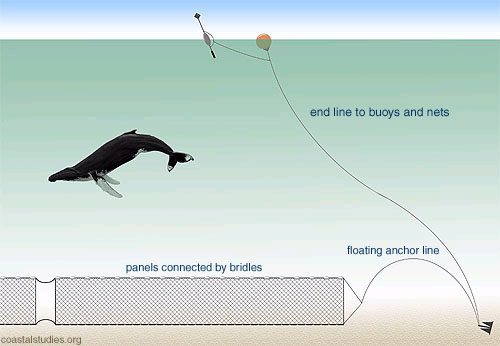Gillnet Diagram

Gillnets are used throughout the North Atlantic and globally. Different mesh sizes can be used to target different species and age classes of ground fish. As schools of fish try to swim through the nearly invisible, mono-filament nets, they are snagged by the gills. Locally, they are used for such species as dogfish, monkfish, hake, cod and haddock. Nets are generally set one day and hauled in the next for a high quality catch. Whales and other non-targeted species may become fouled in this gear.
A buoy, often fitted with a tall radar reflector (high flyer), marks the line connecting either end of a series of mono-filament nets or panels. The nets are held in place by weights (often cinder blocks or an anchor). The top of the net is kept upright in the water column by a series of small floats while the lead-filled bottom line sinks. The bottom bridle, connecting the nets, floats to reduce snagging on rocks. The net panels may be ten feet high (about 3 meters) and 300 feet long (91 meters). Up to ten nets may be joined into one rig.
Gear modifications to reduce whale entanglement rates often concentrate on moving gear from areas where whales are present (dynamic or seasonal area management) or reducing the amount of gear in the water column (ie.: replacing floating lines with neutrally buoyant or sinking lines that stay out of the water column). Entanglements in gillnet have involved all portions of the gear, especially the bridles, anchor lines and end lines.


